AUGUSTE RODIN
- his life, his work (5)
|
|
|
|
|
1889
|
The Eiffel Tower is finished and causes
great protest.
|
|
1890
|
Together with Dalou und colleagues, he founds the Société Nationale des
Beaux-Arts.
In autumn, he travels to the Touraine and the Anjou with Camille.
Rodin gives up his studio at the Boulevard de Vaugirard. In
November, he moves from 71 Rue de Bourgogne to 23 Rue des
Grands-Augustins together with Rose.
Rodin works on 'The little mermaid', 'Iris, the Messenger of the Gods' and on
a bust of Rose and one of Puvis de Chavannes. Intensive studies on 'Victor Hugo'; his first draft for the
Panthéon is refused because Rodin's design does not fit together
with Jean-Antoine Injalbert´s 'Monument to Mirabeau'.
|
|
1890
|
Vincent van Gogh dies the 29th of
July at the age of 47.
|
|
1891
|
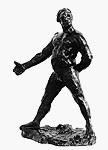 Commission by the Société des Gens des
Lettres for a monument of Balzac; Commission by the Société des Gens des
Lettres for a monument of Balzac;  following the traces of the poet, he
travels to the Touraine with Camille; in a pre-study of Balzac, he first
exposes him all nude and paunchy, later in his preferred work clothes, the
Dominican habit. following the traces of the poet, he
travels to the Touraine with Camille; in a pre-study of Balzac, he first
exposes him all nude and paunchy, later in his preferred work clothes, the
Dominican habit.
Revision of the first, rejected outline of 'Victor Hugo – nude,
surrounded by two muses'. Only in 1901, a marble sculpture of the Poet,
resting on the island of Guernsy, without Muses, was carved for the Salon
and, with the support of Dujardin-Beaumetz, placed in the gardens of the Palais-Royal
in 1909, where it stayed till 1933.
|
|
1892
|
By now, Rodin has six atelier rooms: three studios at the
Dépôt des Marbres, his studio with Camille on 68 Boulevard
d'Italie,
another studio at Nr. 113 and a further studio at 17 Rue du
Faubourg-Saint-Jacques.
He starts hiring more and more assistants.
Rodin is appointed Officer of the Legion of Honor.
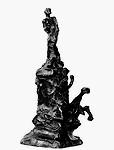 Inauguration of the monument of Lorrain in Nancy on 6 June 1892, the
pedestal shows the God Apollo guiding a chariot. The monument provokes strong
negative criticism; still during the ceremony, the public starts mocking
at the horses. He has to send Victor Peter and Jean Escoula to Nancy, to modify the
pedestal.
Inauguration of the monument of Lorrain in Nancy on 6 June 1892, the
pedestal shows the God Apollo guiding a chariot. The monument provokes strong
negative criticism; still during the ceremony, the public starts mocking
at the horses. He has to send Victor Peter and Jean Escoula to Nancy, to modify the
pedestal.
The installation of the 'Burghers
of Calais' is to be financed by a national subscription and a lottery.
Rodin asks his friend Edmond Bigand-Kaire to purchase a plaster cast of
Camille's bust of Rodin. Since Camille still needs it for an exhibition,
Bigand-Kaire receives it only in July, broken, and glues it together again.
Camille spends some time at the Château d'Islette in Touraine, where she
had been with Rodin before, and invites him to visit her:
"Monsieur Rodin,
with nothing else to do, I write you again. You can't imagine how
beautiful the weather is at Islette. Today I ate in the middle-room (...).
Madame Courcelles has proposed, that if it is agreeable for you, you can
eat there from time to time, even all the time if you wish (actually, I
think it would please her), and it's so beautiful there! (...)
If you are very nice and keep your promise, we can have this paradise
together. You can have any room you wish for your work. I think the old
woman will be at our beck and call. (...)
It would be awfully sweet if you would buy me a bathing suit, two-piece,
dark-blue with white trim (get a medium) from the Louvre or the Bon
Marché (...).
I sleep nude in order to make myself think you are there, but when I wake
it's not the same.
PS: And especially don't deceive me anymore."
Grunfeld and Butler differ on the point if Rodin had actually deceived Camille with other
women by then; Grunfeld quotes Octave Mirbeau, who in July 1889 described
Rodin as " himself the fearsome satyr he depicts in his erotic sculpture"
and reported to Edmond de Goncourt how Rodin, when visiting Monet, had
stared at his four beautiful daughters, so that each of them was obliged
to get up and leave the dinner table.
Whether Rodin actually had other side affairs with his
models or Camille's suspicions were merely rooted in paranoia (as Butler
believes), Rodin's continuing relationship with Rose alone was a source of
permanent jealousy. The same year, Camille starts drawing biting caricatures on Rodin,
unable to free himself from this "collage".
Reine-Marie Paris suggests, Camille may have stayed at the Château d'Islette
to recover from an abortion. In 1976, Romain Rolland's widow reported that Paul Claudel had told her
Camille had been pregnant once by Rodin and had had an abortion, but there
is no definitive evidence for this. Camille's friend Jessie
Lipscomb later even purported, Rodin had two children with Camille, who were
raised in a boarding school. Judith Cladel even suspected, they had four
children, but Rodin denied her question:
"These are just stories. In that case my duty would
have been clear."
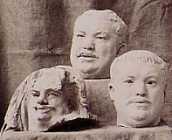 Rodin finishes his outline for the monument of Balzac. Rodin finishes his outline for the monument of Balzac.
The sculptor sometimes combines fragments to create new compositions, so called
"assemblages": 'Farewell' consists of a portrait of Camille, combined
with two hands.
He works on 'The recovering', 'Orpheus, begging for Eurydike's
return'.
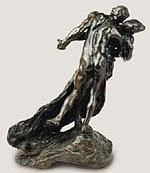 Camille creates the 'Waltz'. The fine arts inspector, Armand
Dayot, requests that the naked couple be draped, although Rodin's 'Kiss'
was accepted as a state commission without such drapery.
The sculpture is shown is shown in the Salon of 1893; in 1895,
Jules Renard wrote:
Camille creates the 'Waltz'. The fine arts inspector, Armand
Dayot, requests that the naked couple be draped, although Rodin's 'Kiss'
was accepted as a state commission without such drapery.
The sculpture is shown is shown in the Salon of 1893; in 1895,
Jules Renard wrote:
"In this group of a waltzing couple, they seem to want
to finish the dance so they can go to bed and make love."
.
A copy of 'The Waltz' was owned by Claude
Debussy, who may have had an intimate but unhappy affair with Camille.
|
|
1893
|
In February-March, Rodin and Rose move from their narrow
place in the Rue des
Grands-Augustins to the former house of
the dramatist Eugène Scribe in suburban Bellevue, between Sèvres and
Meudon. Rodin installs his atelier on the large top floor and takes a
distance from the problems and pressures of Paris circles. He enjoys the
view on the river, the garden, chatting with the neighbours.
As a man of
growing wealth, he also starts to build a private collection of antique
sculptures and impressionist paintings.
For Camille, who does not want to confine herself to the role of a mistress and assistant,
this retreat into a more private existence together with Rose is a defeat; she finally has to realize that she cannot win Rodin.
By the end of 1893, she makes first sketches for a group of three
figures: a man torn between an old and a young woman: 'Maturity'.
Rodin takes the chair of Dalou for the Société Nationale des Beaux-Arts
in
the section sculpture.
A heavy flu is bothering him.
The medaillon of César Franck, which was commissioned in 1891, is placed
on Franck's tomb in the cemetery of Montparnasse. Rodin has to intervene
to have it mounted in the right position.
|
|
1893
|
Edvard Munch paints the 'Cry'.
|
|
1894
|
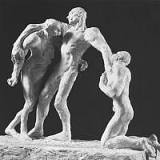 In
'Maturity' (1894-95), Camille Claudel depicts the fatal triangle
relationship between Rodin, Rose, and herself, assigning the role of Death
to Rose. She keeps the work hidden for Rodin; the pair has no contact
during two years. In
'Maturity' (1894-95), Camille Claudel depicts the fatal triangle
relationship between Rodin, Rose, and herself, assigning the role of Death
to Rose. She keeps the work hidden for Rodin; the pair has no contact
during two years.
Rodin travels to the South of France and to Switzerland. He visits Monet in Giverny and there meets Cézanne, Clemenceau, Mirbeau
and Geffroy.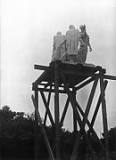
He surveys the location in Calais for his 'Burghers' monument and proposes
it to be placed either on ground level or on a high pedestal.
Rodin receives a commission for a monument of the Argentinian statesman
Sarmiento in Buenos Aires (inaugurated in 1900).
The
Société des Gens de Lettres puts pressure for the completion
of the Balzac statue, because Rodin has exceeded the delivery time by long
now.
|
|
1895
|
'The Burghers of Calais' are inaugurated at its final location; they
are presented on a medium high pedestal, designed by the city architect
Decroix, with an octagonal iron gate around it; this is nearly the opposite of Rodin's suggestion for
installation.
Rodin catches a glimpse of Camille at a vernissage and writes to her.
He takes the chair for the Banquet to Puvis de Chavanne.
Rodin is invited to the salon of the composer Ernest Chausson.
On 19 December, Rodin bids 27,800 FF for the Villa de Brillants in
Meudon, built by the sculptress Delphine Arnould de Cool.
. Here he will spend his remaining years together with Rose.
|


|